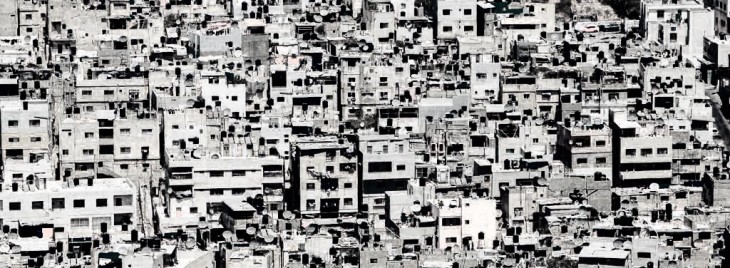Gilles Deleuze and Félix Guattari describe the space as a diversity of lines, which each get their identity from the environment. They describe the complete set of connections of particles as the Rhizome.
The rhizome is like a structure of roots, though it is different from the roots of a tree, because it is asymmetric and decentralized. It can be In that way the rhizome can be combined and connected in infinite. In a rhizome any given point can be connected to another (principle of rhizome 1+2; connections and Heterogenety). The rhizome has many entryways. Rhizome is based on multiplicities. The multiplicity should be treated as a substantive (principle of rhizome 3; Multiplicities).
The rhizome might be better understood if you compare it to the root structure of the grass or a potato – an unbounded structure which connects different units together and it grows in between and has no units, only dimensions. All points are always joined in a movement from one identity to another.
The rhizome is not tracing, but it is mapping. “The orchid does not reproduce the tracing of the wasp; it forms a map with the wasp, in a rhizome.”1 (principle of rhizome 5+6; Decalcomania and Cartography) When you try to replicate the rhizome, it will only from new ramifications and relations (principle of rhizome 4; Asignifyring rupture). This means that nothing is rooted and no truth is given.
Gilles Deleuze and Félix Guattari questions the western worlds rational and logical approach to knowledge and make patterns/tracings of the mind (fx Sigmund Freud´s Psychoanalyze) and for example the planned cities. Is the most of the eastern world based on rhizomes?
Concerning architecture the rhizome has many aspects. One is the multiplicity of interactions which might be made possible through architecture. Using the thoughts of rhizome can help to erase borders and hierarchy in the structures of masterplans or building design. Architecture without starting and ending – the architecture of gradients (read Sui Fujimoto). The reference to rhizome could be the internet (decentralized and infinite entryways etc.) and shanty towns or refugee camps (growing, decaying and spreading by the not planned events of necessities). But how can we “control” the rhizome? And where does this put the architect? It is more less the same paradox, that there were with the atmospherically machinery at “new babylon” (Constant Niewenhuys).
The hard task is to design a space that takes into account that all the elements of the spaces is combined and are defining the identity by the rhizome. The rhizome is like the “short term memory” and we plan our cities and understand them by our “long term memory”. It is easy to relate to the known realities in a city, but never the unknown factors of the city.
We should as architects try to understand the “strata” (homogenisis) as the inner process of the rhizome (like Manuel DeLanda). In that way we give our design the best condition to perform best, when learn about the virtual potentiality. But we should be aware of the rhizome, which I do not think we can control. The rhizome is the uncontrolled environment (selfconsistent aggregat), which direct the design in different directions. D´arcy Wentworth Thomsen was also aware that it not was only the evolution (Darwin) that were driving the evolution of the species. The environment (homology) and the rhizome had a deep impact of the growth and forms of for example branches and human faces.
A possible topic for my personal research could be to investegate, how architects over time have been using the digital logics to explore the rhizome in architecture. Like the “Blur” (by Diller Sciofidio Renfro) tries to deal with the rhizome, in a more or less controlled way.
The next topic could be how we can learn our digital tools to use the “short term” memory and create more “real” rhizomes? But I think we should rise a very crucial question; are we destroying the rhizome by trying to understand it and program it? Maybe the rhizome is best without the definition.
1 Gilles Deleuze and Félix Guattari A Thousand Plateaus, – page 12
Picture: http://emptyencore.files.wordpress.com/2011/04/1219079139.jpg

